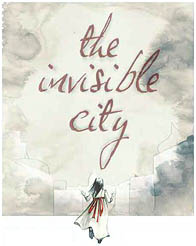In his 1978 novella, Invisible Cities, Italo Calvino describes imaginary conversations between Kublai Khan and Marco Polo; conversations in which the Italian explorer relays his experiences of the world’s great cities.

The Invisible City
As Polo recounts a multitude of urban centres, it becomes apparent that he is relating the different urban experiences of his own native Venice.
Calvino’s metaphysical treatise on the nature of memory and experience seems an unlikely starting point for a modification, or ‘mod’ of the classic 3D shoot-em-up Unreal Tournament (UT), but it’s fair to say The Invisible City is no ordinary mod. Developed over a lightening-fast five-week period, the project was produced by RMIT postgraduate animation and interactive media students, to simulate the experience of a production studio.
While project coordinator John Power stresses that The Invisible City was conceived as a mechanism for giving students “a simulation of a complex, role-based production”, the underlying nature of the project – in which the guns-and-glory world of UT is disarmed – makes it easy to view The Invisible City as a comment on the violent nature of computer games, or even the
world at large.
However, it’s a view Power readily rejects. “Everybody talks about that”, he said. “But it’s been written into the game in a meaningful way. We didn’t say ‘Oh look, it’s non-violent’. It’s part of the structure. You don’t think about it one way or the other.” Power’s assertion is quickly backed up after a turn at the controls. His team have altered UT’s arsenal, so instead of, say, picking up a 12-gauge to blast an ungodly monster, you grab an old photograph to help piece together the game’s atmospheric mystery. Instead of ammunition packs, there are quotes from Calvino’s surreal text littering back alleys of the eerily empty town.
Power, who enjoys the odd blast on UT, was attracted to the game as an educational tool because of the GUI that shipped with the 2004 edition. This “Lego kit”, as Power describes it, made it a “cheap, accessible and fairly robust” way of bringing Calvino’s themes of memory and identity to a 3D environment. The free model editor, skin painter, script authoring and debugging software have inspired an extensive, supportive community of UT modders. Their shared online tutorials provided a how-to manual for Power and his team. Although drawing on the experience of more traditional modders, the finished product stands on its own as a unique artistic work. Helping to emphasise the game’s theme of urban dislocation is the union of two-dimensional hand-drawn animation with the 3D environment. While only part of the world of The Invisible City – seen in ghostly characters and in the facades of buildings – the inter-meshing of media gives the game a tactile and organic dimension that shifts the boundaries of the 3D gaming experience.
Production
Most production was performed using the UT editing tools, but team-member Darren Ballingall provided some original tech fixes, such as the removal of weaponry. While UT encourages modding of their games, they prohibit unauthorised commercial usage of their engine. For artists, this makes selling a stand-alone version of The Invisible City impossible, although it can be distributed for free, and played by anyone who owns a commercial version of UT. The actual use restrictions don’t prevent the team from showing The Invisible City at any future art exhibitions, however they would be legally obliged to obtain permission if they were to receive an artist’s fee. Epic Games have not been known to chase up commercially insignificant usages like these.
Tim Campbell
Tim Campbell is a visual artist, designer and journalist, providing commentary on popular culture, sport, film and games.
 This work is licensed under a Creative Commons Attribution-NonCommercial-ShareAlike 2.5 Australia.
This work is licensed under a Creative Commons Attribution-NonCommercial-ShareAlike 2.5 Australia.






